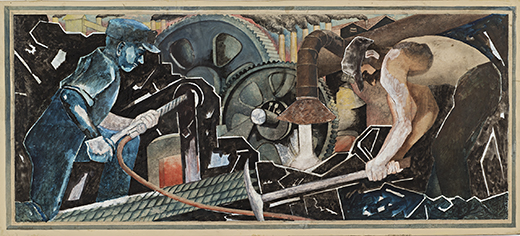Larger than life: Beach Museum of Art exhibition explores American murals of the New Deal
Tuesday, Feb. 26, 2019

"Steel Workers," by brothers Philo and John Ruggles, done in gouache, watercolor and graphite on thick cardboard, was an unsuccessful entry in the Treasury Section of Painting and Sculpture program's "48 States Competition." The 1939 work was considered for the Bridgeport, Ohio, Post Office. The Ruggles were artists from the Bronx, New York. | Download this photo.
MANHATTAN — The backbone of America — the everyday worker — stars in the Marianna Kistler Beach Museum of Art exhibition "Celebrating Heroes: American Mural Studies of the 1930s and 1940s from the Steven and Susan Hirsch Collection."
The exhibition runs March 5-June 15 in the Marion Pelton and Hyle Family galleries of the Kansas State University art museum.
Organized by the Frances Lehman Loeb Art Center at Vassar College in Poughkeepsie, New York, "Celebrating Heroes" features more than 50 drawings that provide an intimate look at the thinking processes of artists who competed for New Deal mural commissions in the 1930s and 1940s. During this golden age for murals in America, the participants in President Franklin Roosevelt's jobs programs for artists took inspiration from the panels of Mexican muralists in which everyday workers became monumental heroes.
"This exhibition explores how farmers, miners, American Indians and settlers all found a place in the government murals that still greet visitors today in sites such as post offices and schools," said Elizabeth Seaton, Beach Museum of Art curator. "The colorful and dynamic preliminary studies offer insights into artists' thoughts about interpreting history, the notion of a 'hero' and democratic ideals, topics still relevant today."
Most of the drawings in "Celebrating Heroes" are from the New Deal's Treasury Section of Painting and Sculpture program, offered from 1934 to 1943, which sponsored anonymous competitions open to any American artist. The artists selected were encouraged to paint in a representational style and to depict regional subjects. Program administrators encouraged artists to work with local authorities and residents, in person or by mail, to develop themes of interest. Few of the artists painted on site; most murals were produced in studios and then adhered to the wall.
Sometimes the murals were met with controversy. For example, "Celebrating Heroes" includes murals by progressive artist Anton Refregier for San Francisco's Rincon Annex Post Office. Some of his murals depicted class conflict or ethnic prejudice and drew the ire of various groups such as the American Legion.
The "Celebrating Heroes" exhibition also features several special events. The documentary "A New Deal for Public Art in the Free State" will be screened and include a post-discussion with filmmaker Kara Heitz. The event will take place at 5:30 p.m. Thursday, April 25, at Beach Museum of Art. Heitz's film documents the history of murals painted for Kansas post offices as part of New Deal arts programs. "A New Deal for Public Art in a Free State" is by Clio's Scroll Productions LLC in conjunction with the Birger Sandzén Memorial Gallery in Lindsborg and funded by a grant from Humanities Kansas.
"Heroes for Hard Times: American Art During the 1930s and 1940s" is the title of a talk to be given by Lara Kuykendall, associate professor of art history at Ball State University, at 5:30 p.m. Thursday, May 2, at the Beach Museum of Art. The talk will explore the ways in which American artists used heroic characters to symbolize national ideas and aspirations during the global crises of the 1930s and 1940s.
Both the film screening and talk are free and open to the public. Visit beach.k-state.edu for more details about each event.
The Beach Museum of Art, at 14th Street and Anderson Avenue, is open Tuesday, Wednesday and Friday from 10 a.m. to 5 p.m.; Thursday from 10 a.m. to 8 p.m.; and Saturday from 11 a.m. to 4 p.m. Admission is free and free parking is available adjacent to the museum.
